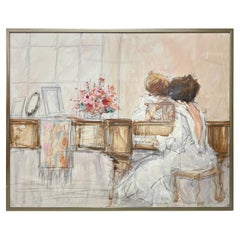Jerry Sic
Recent Sales
Vintage 1980s Minimalist Decorative Art
Paper
A Close Look at Minimalist Furniture
A revival in the popularity of authentic Minimalist furniture is rooted in history while reflecting the needs and tastes of the 21st century. Designer Ludwig Mies van der Rohe’s aphorism that “less is more” influenced the evolution of 20th-century interiors with an emphasis on function and order. This was a shift from the 19th century, with its lavish Victorian decorating, and was spread around the world through design styles including Bauhaus and brutalism.
Yet Minimalism was present in furniture design long before the clean lines of modernism, such as in the simple and elegant utility of Shaker furniture. Although the Minimalist art movement of the 1960s and ’70s had little crossover with furniture design, artist Donald Judd was inspired by the Shakers in creating his own spare daybeds and tables from sturdy wood. (Judd, whose advocacy of symmetry also informed his architectural projects, furnished his Manhattan loft with unassuming but poetic works by iconic modernist designers such as Gerrit Rietveld and Alvar Aalto.)
Understatement rather than ornamentation and open space instead of clutter are central themes for a Minimalist living room and bedroom. As opposed to Maximalism, the focus for Minimalist furniture and decor is on simplicity and considering the design and purpose of every object.
Furnishings are usually made in neutral or monochrome colors and pared down to their essentials — think nesting coffee tables, sectional sofas and accent pieces such as ottomans. And Minimalist ceramics can help achieve a decor that is both timeless and of the moment. The organic textures and personalization of handmade craftsmanship associated with these works have served as a sort of anti-Internet to screen-weary decorators. That said, while the thoughtful ergonomics of Scandinavian modern furniture, with its handcrafted teak frames, are at home in Minimalist spaces, so are the quietly striking pieces by Japanese designer Naoto Fukasawa that employ industrial materials like stainless steel, aluminum and plastic.
Minimalist furniture is not for making flashy statements; it boasts subdued appeal and excels at harmonizing with any room. And, as it encompasses many different movements and eras of design, it also never goes out of style, owing to its tasteful refinement.
Find a collection of Minimalist tables, seating, lighting and more furniture on 1stDibs.
Finding the Right Decorative-art for You
Antique, new and vintage decorative art is crucial to personalizing your interior.
Bringing art into your home will help you create a warm and welcoming atmosphere, whether you are expecting to regularly host guests for cocktails in your living room or you are inclined to soak up some “me time” on weekends by curling up with a book in your library. After all, a room isn’t quite complete until you hang some art on the walls.
Choosing a piece of art for your interior is a matter of finding something that resonates with you. You should also consider what will work with your current decor. Keep in mind that a wide range of objects counts as decorative art — antique and vintage prints, paintings, wall-mounted sculptures and more. There is so much to choose from! And art can feel as deeply personal with the vintage posters that promoted your favorite classic films as it can with framed photographs of your loved ones.
Decorative art can set the mood for a room and will typically make for great conversation. When you find wall decor and decorations that speak to you, why not introduce them into your space? It will give you and your guests the opportunity to meaningfully engage with the art every time you see it. You can play with different styles, eras and colors. Mix and match pieces to integrate a refreshing pop of color or create a theme by dedicating a room to a color palette or certain time period. A great way to tie your layout together is to choose wall art that complements your decor and color scheme.
Folk art is an interesting category for its wide range of works across various media and the array of textures it can offer. Paper art is another versatile option because it will be easy to find a home for portraits, collages, drawings and other works in your space. With decorative paper art, you can also get creative with how you arrange your wall art. There are plenty of options that include hanging the works salon-style.
On 1stDibs, find a constantly growing collection of antique and vintage decorative art today.
